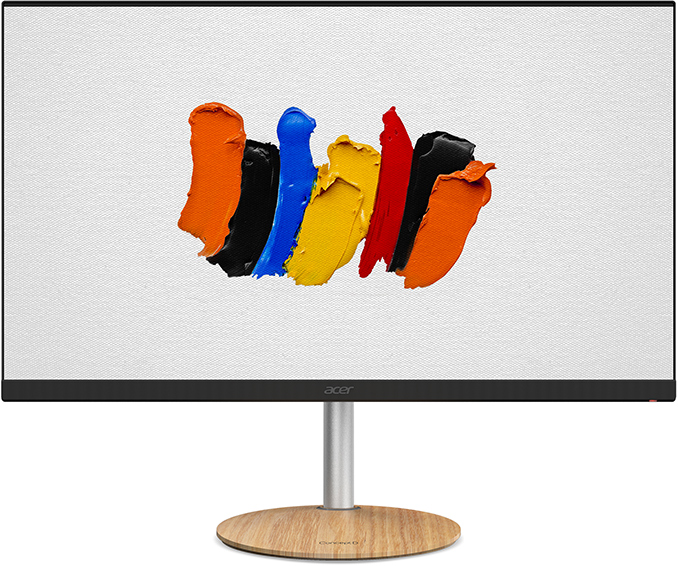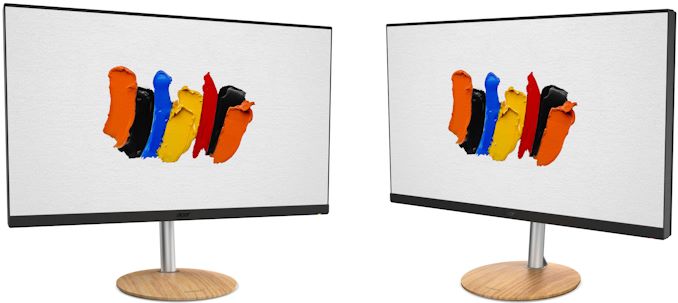Acer Joins Mini LED Monitor Club with Professional-Focused ConceptD CM7321K
by Anton Shilov on April 19, 2019 4:45 PM EST
As the era of Mini LED backlighting takes off in earnest, Acer has become another major supplier of displays to announce a monitor incorporating the tech. The ConceptD CM7321K is a high-end PC monitor that will be aimed at graphics and video professionals who need a wide color gamut, a high contrast ratio, a very high luminance, and a Delta E<1 color accuracy.
Acer's ConceptD CM7321K monitor uses a 10-bit 31.5-inch IPS panel featuring a 3840×2160 resolution, 600 - 1000-nits brightness (typical and peak in HDR mode), a 4 ms response time, a 60 Hz refresh rate, and 178°/178° horizontal/vertical viewing angles. The key feature of this display is its backlighting, with 1152 Mini LED zones for dynamic local dimming.
Backlighting based on hundreds (or thousands) of independently-controlled Mini LEDs promises to bring capabilities of LCDs closer to those of OLEDs when it comes to contrast ratio, color gamut, and brightness. Leading panel suppliers demonstrated prototypes of products outfitted with this kind of backlighting last year, with plans on the TV side of matters to start commercial shipments of Mini LED Ultra-HD televisions in 2019. As it appears, Acer and ASUS will be ready with their PC displays featuring this innovative backlighting this year as well.
In case of the ConceptD CM7321K monitor, thanks to its Mini LED-based full area local dimming (FALD) backlighting with 1152 zones, Acer is rating its contrast ratio as 100,000,000:1 when adaptive contrast management (ACM) is in use, Though it goes without saying that like other adaptive contrast setups, Acer's ACM contrast ratio should not be compared head-to-head to 'usual' contrast ratio reported by manufacturers. Meanwhile the wide spectrum of the backlight means that the display can cover 99% of the AdobeRGB and 89.5% of the Rec.2020 color gamuts.
To ensure that professionals get a good experience out of the box, Acer has validated its ConceptD CM7321K with Pantone color institute, and will ship the monitor pre-calibrated to a Delta E<1 color accuracy (presumably for all color gamuts it will support). The display also carries VESA's DisplayHDR 1000 badge, so it meets the VESA's highest standards for a HDR monitor, and this means it will support at least HDR10 (no word on Dolby Vision, though).
As far as connectivity is concerned, the monitor has two Thunderbolt 3 connectors (one input and one output to daisy chain two LCDs), four HDMI 2.0b inputs, as well as one DisplayPort 1.2. In addition, the display has two 3 Watt speakers.
| Brief Specifications of the Acer ConceptD CM7321K | ||
| Panel | 31.5" IPS | |
| Resolution | 3840 × 2160 | |
| Refresh Rate | 60 Hz | |
| Response Time | 4 ms gray-to-gray | |
| Brightness | Normal: 600 cd/m² HDR mode: 1000 cd/m² |
|
| Contrast | 100,000,000:1 (ACM) |
|
| Viewing Angles | 178°/178° horizontal/vertical | |
| Color Saturation | 99% Adobe RGB 89.5% Rec. 2020 ? DCI-P3 |
|
| Display Colors | 1.07 billion | |
| 3D-LUT | ? bits | |
| Pixel Pitch | 0.1816 mm² | |
| Pixel Density | 140 PPI | |
| Anti-Glare Coating | ? | |
| Inputs | 1 × DP 1.2 4 × HDMI 2.0b 1 × Thunderbolt 3 (one output) |
|
| USB Hub | ? | |
| Audio | 2 × 3 W speakers 3.5-mm mini jack (?) |
|
| Mechanical Design | Chassis Colors: black, metallic. wood Tilt: yes Height Adjustment: yes Swivel: yes |
|
| Power Consumption | Idle | ? |
| Active | ? | |
Finally, the high-end display will be hitting the streets in September, and with a price tag to match: Acer will be selling the monitor for $2,999/€3,199 (MSRP). Given the cutting-edge nature of Mini LED backlighting, this is not particularly surprising, as they'll make up a significant portion of the build costs on all of these first-generation Mini LED monitors.
Related Reading:
- ASUS Shows Off Dolby Vision Monitors: The ProArt PQ22UC & ProArt PA32UCX
- The New Acer ConceptD Family: Workstations and Displays for Professionals
- ASUS at CES 2019: ProArt PA32UCX 4K Monitor with 1000-Zone FALD Unveiled
- Acer Unveils ProDesigner BM270 LCD with Delta E<1 Color Accuracy: 4K, HDR, FALD
Source: Acer











30 Comments
View All Comments
ABR - Saturday, April 20, 2019 - link
Just no. Local area dimming is not and will never be it. About 40 x 25 "pixels" worth of blurry light control?! Think that's gonna look good? Just work on solving OLED's problems already.crimsonson - Monday, April 22, 2019 - link
For professionals, OLED is not the end all/be all solution. It is much more expensive and the life span is far shorter than LCD. Even the Sony X300 at $32K has already reports of shifting colors after 2 years! Some even less!! Sony is planning to leave OLED in the high-end pro market. Shifting to double layer LCD.There has to be more options not just one panel type.
FreckledTrout - Monday, April 22, 2019 - link
Actually FALD depending on the number of mini LEDS could be a perfect compromise that produces almost OLED level contrast and brightness. Say for example if there are 50K mini LEDS for the backlight? There is a point where there is enough it isn't perceptible versus OLED then you get all the benefits of LCD like no burn in or color fading over time etc.Devo2007 - Sunday, April 21, 2019 - link
A $3000 professional 31" monitor with only 89.5% Rec. 2020 color gamut? Fail!Devo2007 - Sunday, April 21, 2019 - link
Wait, I got confused between Rec. 2020 & DCI-P3. That actually is better than quite a few other displays.crimsonson - Monday, April 22, 2019 - link
Yea 89% for Rec 2020 is excellent compared to current offerings. Obviously, 100% is the goal, but even in the high-end pro market that is not reasonable today.Santoval - Sunday, April 21, 2019 - link
If Acer are only reporting the "adaptive" (the new name for "dynamic" apparently) contrast ratio of this monitor that apparently means that its true (static) contrast ratio is pretty low. The problem is that professionals are not going to be fooled by contrast ratio marketing tricks such as this. They are not naive average Joe consumers, they are people who are very well versed in such stuff, because it is their freaking *job*.If Acer want to sell monitors to professionals they need to learn how to properly market the monitors for professionals. If they are not confident enough in their monitors that they think they need to resort to deceptive marketing tricks in order to sell them, then they should just not make monitors targeted at professionals, because such tricks are not going to work on them.
edzieba - Monday, April 22, 2019 - link
'Professionals' looking at FALD monitors know that contrast ratio of the LCD panel itself does not tell the whole story when it comes to displaying HDR images.Beaver M. - Sunday, April 21, 2019 - link
Why is 60 Hz still standard in 2019?It was in the 90s...
3k for a 60 Hz display? I guess their market studies say that there are enough idiots.
Devo2007 - Sunday, April 21, 2019 - link
For the target market (video / photo creation) more than 60Hz isn't needed. Color accuracy is the most important thing here. Yes, a higher refresh rate can improve smoothness, but when working with content that is only going to be 60fps at most, there's no real need for it.If you want a monitor that will be good enough for most content creators + games, there's plenty of other options available.